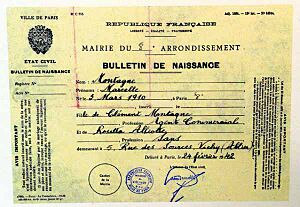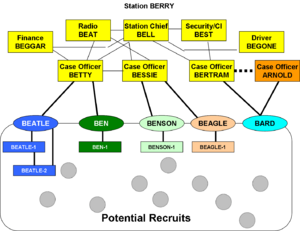Cover (intelligence gathering) facts for kids
A cover in the world of espionage is like a secret identity. It's the fake job, role, or even personality that a secret agent uses when they are working undercover. This helps them blend in and hide their true mission.
Contents
What is a Spy's "Cover"?
When a spy goes on a secret mission, they often need to pretend to be someone else. This fake identity is called their "cover." It helps them gather information without anyone knowing they are a spy. A cover can be a new name, a different job, or even a whole new backstory.
Official Cover: Spies with Diplomatic Protection
Some spies work under what's called an official cover. This means they have a job that is officially linked to their government, like working at an embassy or consulate in another country.
The big advantage of an official cover is something called diplomatic immunity. This is a special protection that means they can't be arrested or punished like regular citizens if they are caught spying. Instead, if their secret activities are discovered, the country they are in usually just tells them to leave. This is called being declared persona non grata, which means "an unwelcome person."
These agents are officially recognized by their home country. If they get into trouble, their government can step in to protect them.
Non-Official Cover: Spies Without a Safety Net
Operatives under non-official cover (often called NOCs) are spies who do not have any official ties to their government. They work in secret roles, often pretending to be regular people like business owners or aid workers.
Unlike agents with official cover, NOCs do not have diplomatic immunity. This means they don't have a "safety net." If they are caught spying, they can face very serious punishments, just like any criminal in that country. Their government will usually deny knowing them. This is called plausible deniability, meaning their government can pretend they had nothing to do with the spy.
What is a "NOC"?
The term "NOC" is pronounced like "NOK." Sometimes, these agents are also called "illegals." To help them create their fake identities, spy agencies might set up fake businesses. These "front companies" give the agents a believable reason to be in a certain place or do certain things.
How Spies Use Cover in History

Throughout history, spies have used many different types of cover. For example, a spy might pretend to be a businessperson, someone working for a charity, or a university student. This helps them move around and gather information without drawing attention.
Many agents who are honored on the CIA Memorial Wall are believed to have been NOC agents. They were often killed or captured while working in foreign countries. However, many captured NOC agents have been sent back to their home countries. This often happens through "prisoner exchanges," where two countries swap captured spies.
Some countries have rules about how non-official cover can be used. For instance, the CIA has sometimes been forbidden from having agents pretend to be members of certain aid groups or religious leaders.
The fake stories created for non-official cover can be very simple or very complex. Sometimes, an agent just gets a job at a real company. Other times, entire fake companies are created just to give agents a believable cover story. For example, Air America was an airline used by the CIA during the Vietnam War. Another example is Brewster Jennings & Associates, a fake company used by the CIA for investigations.
Fictional Spies and Their Covers
You can see examples of spies using cover in many popular books, movies, and TV shows. Some famous fictional examples include characters in the movies Mission: Impossible, Spy Game, and The Bourne Identity. TV shows like The Americans and Burn Notice also show characters working under non-official cover.
See Also
- Illegals Program
- Secret identity
- Sleeper agent


